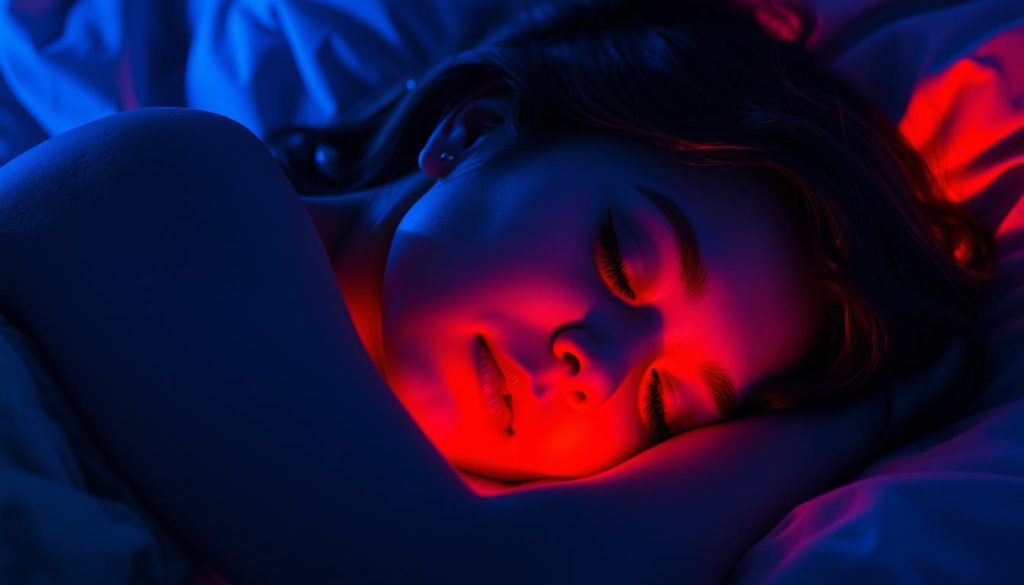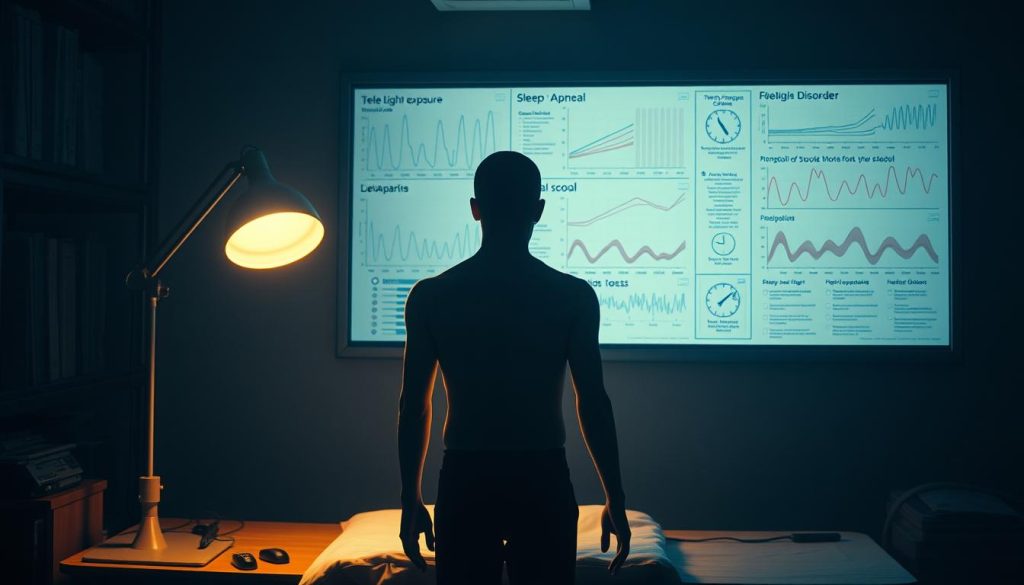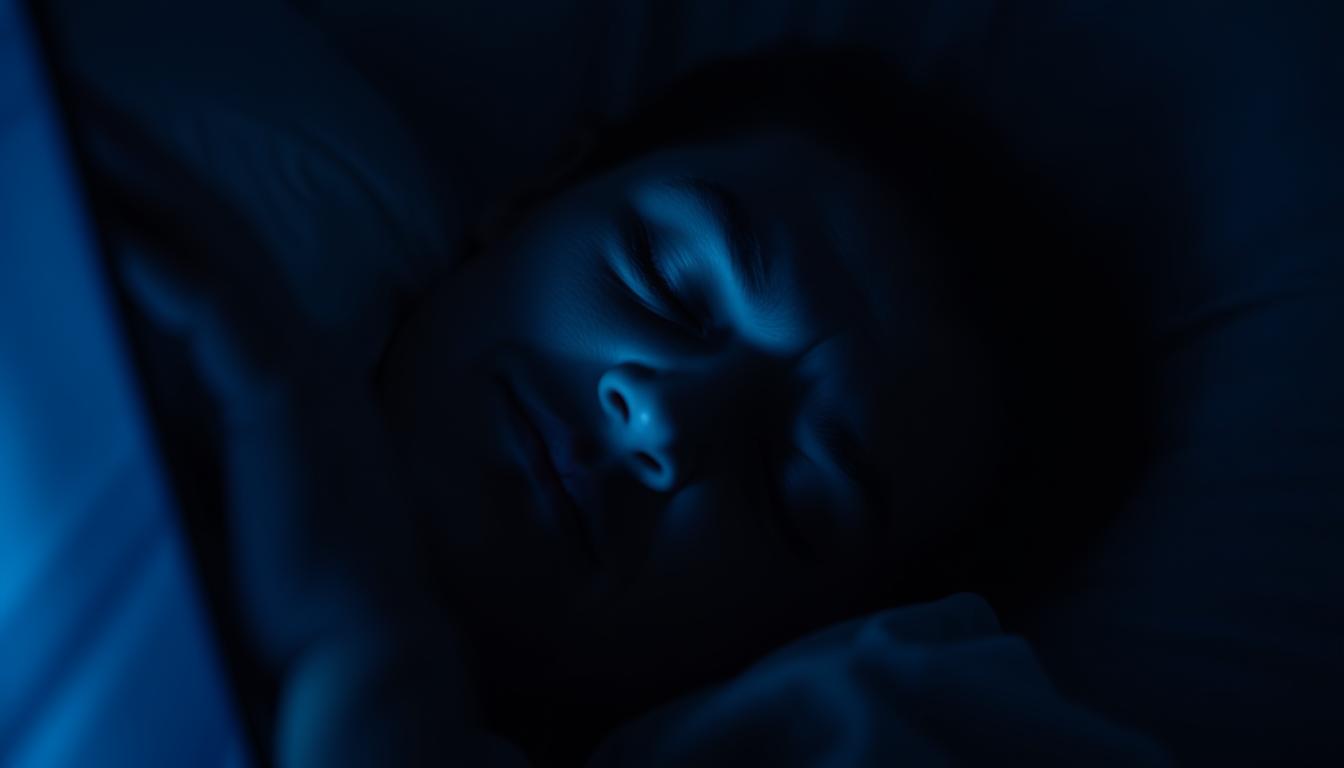Have you ever wondered how your surroundings impact your rest? The relationship between sleep apnea and light exposure is more significant than you might think. Research shows that even low levels of ambient light at night can disrupt melatonin production, affecting your overall sleep quality.
Your body’s internal clock, or circadian rhythm, is highly sensitive to changes in light. Modern lifestyles often expose us to artificial light sources, which can throw this rhythm off balance. This disruption can lead to difficulties in achieving restful nights.
In this article, we’ll explore how light exposure influences sleep patterns and share practical tips to improve your sleep quality. Understanding this connection can help you make small changes for better rest.
Understanding Sleep Apnea and Light Exposure
Your surroundings play a bigger role in rest than you might realize. One common disorder, sleep apnea, disrupts regular breathing cycles. This condition can lead to fragmented rest and lower overall quality of life.
Artificial light at night is a major factor in this disruption. It prevents the body from releasing melatonin, the hormone that signals it’s time to rest. Without this signal, the body struggles to achieve deep, restorative rest.
The effect of light exposure isn’t limited to nighttime. Early morning light can also interfere with the body’s natural rhythm. This dual impact can leave you feeling less alert during the day.
Understanding this connection is crucial for improving health. Small changes, like reducing artificial light at night, can make a big difference. Here’s a quick comparison of how light exposure affects rest at different times:
| Time of Day | Effect on Rest |
|---|---|
| Night | Disrupts melatonin production, leading to fragmented rest |
| Early Morning | Interferes with natural wake-up signals, reducing daytime alertness |
By addressing these factors, you can take steps toward better rest and improved health. Awareness of light’s role is the first step in making meaningful changes.
The Science Behind Light and Melatonin Production
Ever thought about how light affects your body’s internal clock? The relationship between light and melatonin is key to understanding rest regulation. Melatonin, often called the “sleep hormone,” helps signal when it’s time to wind down. However, bright light can interfere with this process.
How Light Inhibits Melatonin Secretion
When your eyes detect bright light, especially in the evening, it sends a signal to your brain. This signal suppresses melatonin production. The process starts in the retina, where specialized cells detect light and communicate with the brain’s pineal gland. This gland is responsible for releasing melatonin.
Studies show that exposure to bright light before bedtime can delay melatonin onset. This delay shortens the duration of melatonin production, making it harder to achieve deep rest. Even low levels of artificial light can have a similar effect.
The Role of Melatonin in Sleep Regulation
Melatonin plays a crucial role in maintaining a healthy rhythm. It helps your body transition from wakefulness to rest. The timing of melatonin onset is critical. It typically begins to rise in the evening, peaking during the night, and gradually decreasing by morning.
Here’s how melatonin works to regulate rest:
- Signals the body to prepare for rest.
- Helps maintain a consistent rhythm.
- Supports deep, restorative phases of rest.
Managing light exposure is essential for optimizing melatonin production. Simple changes, like dimming lights in the evening, can make a significant difference. Understanding this connection empowers you to take control of your rest quality.
Exploring the Circadian Rhythm and Its Disruption
Have you considered how your daily habits influence your internal clock? The circadian rhythm, often referred to as the body’s natural clock, plays a vital role in regulating your daily cycles. It helps your body know when to rest, wake, eat, and perform other essential functions.
What Is the Circadian Clock?
The circadian clock is a 24-hour internal timer that governs your body’s functions. It responds to environmental cues, like light and darkness, to maintain a consistent rhythm. This clock ensures that your body operates efficiently throughout the day.
When your circadian clock is in sync, you feel alert during the day and ready to rest at night. However, irregular light exposure can throw this delicate balance off. For example, bright lights at night can confuse your clock, delaying the signals that prepare your body for rest.
Consequences of Disrupted Sleep Cycles
Disruptions to your circadian rhythm can have far-reaching effects. Research shows that irregular light exposure can lead to fragmented rest and reduced alertness during the day. Over time, this can increase the risk of developing sleep-related disorders.
Here’s how a disrupted clock impacts your health:
- It confuses your body’s natural timing, making it harder to fall asleep.
- It reduces the quality of rest, leaving you feeling less refreshed.
- It can contribute to long-term health issues, including metabolic and mood disorders.
Maintaining a regular light-dark cycle is essential for keeping your circadian clock on track. Simple changes, like dimming lights in the evening and getting sunlight in the morning, can make a big difference. By understanding the importance of your internal clock, you can take steps to improve your overall well-being.
Light Pollution and Its Impact on Sleep Quality
Urban environments are filled with artificial brightness, but how does it affect your nightly rest? Light pollution, the excessive or misdirected artificial light in cities, has become a growing concern. Common sources include streetlights, billboards, and even residential lighting. This constant glow can interfere with the natural darkness needed for restorative rest.
Excessive exposure to ambient light, even from outdoor sources, disrupts the body’s ability to wind down. Studies, including a 2016 report, show that even low levels of artificial brightness can reduce rest quality. This interference makes it harder to achieve deep, uninterrupted cycles.

The role of light level is crucial. While dim lighting can signal the body to prepare for rest, bright or inconsistent lighting confuses the internal clock. This confusion leads to fragmented rest and reduced alertness during the day. Over time, these disruptions can negatively impact overall health.
Urban light pollution has been linked to decreased rest health. Residents in brightly lit areas often report shorter, less restful nights. Controlling local light levels, such as using blackout curtains or dimming outdoor lights, can help mitigate these effects.
Here’s a comparison of how different light levels influence rest quality:
| Light Level | Effect on Rest Quality |
|---|---|
| Low (Dim) | Promotes relaxation and signals the body to prepare for rest |
| Moderate (Ambient) | Can delay rest onset and reduce rest depth |
| High (Bright) | Disrupts the internal clock, leading to fragmented rest |
By understanding the impact of light pollution, you can take steps to improve your nightly rest. Simple changes, like reducing artificial brightness in your environment, can make a significant difference in your overall health and well-being.
Unpacking Research on Urban Light Exposure
What does research say about the effects of urban environments on nightly rest? A 2016 study provides valuable insights into how artificial brightness impacts our daily cycles. This research focused on urban participants, examining the link between light exposure and rest disturbances.
The study involved monitoring participants’ exposure to outdoor brightness over a specific duration. Researchers found that even minimal levels of artificial light increased rest disturbances. Participants reported higher levels of daytime sleepiness and fatigue.
Key findings from the study include:
- An association between longer duration of light exposure and reduced rest quality.
- Increased confusion and fatigue among participants exposed to urban brightness.
- A clear link between nighttime light exposure and health risk factors.
Here’s a summary of the study’s outcomes:
| Factor | Impact |
|---|---|
| Duration of Light Exposure | Longer exposure led to more rest disturbances. |
| Daytime Sleepiness | Participants reported higher levels of fatigue. |
| Health Risks | Increased association with metabolic and mood disorders. |
This research highlights the importance of managing urban light exposure. By understanding these findings, we can take steps to improve our daily cycles and overall health.
The Effect of Artificial Light on Overall Sleep Health
Artificial brightness from screens and indoor lighting can significantly alter your nightly rest. Unlike natural light, which follows a predictable pattern, artificial sources often disrupt the body’s internal clock. This disruption can lead to symptoms like excessive daytime sleepiness and impaired rest quality.
Studies show that prolonged exposure to artificial brightness, especially in the evening, confuses the body’s natural rhythm. This confusion makes it harder to fall asleep and stay asleep. Over time, these disruptions can affect overall health and daytime performance.
Research highlights that women are particularly affected by artificial light. Hormonal changes and lifestyle factors make them more sensitive to disruptions in their nightly cycles. This sensitivity can lead to a higher risk of rest-related issues.
Here’s how artificial light impacts rest duration and quality:
- Delays the onset of rest by suppressing melatonin production.
- Reduces the depth of rest, leading to less restorative cycles.
- Increases daytime fatigue and reduces alertness.
Mitigating these effects is crucial for preserving rest health. Simple changes, like reducing screen time before bed and using dim lighting, can make a big difference. By understanding the impact of artificial brightness, you can take steps to improve your nightly rest and overall well-being.
Managing Sleep Apnea and Light Exposure
Managing a specific condition effectively often requires small but impactful changes in daily habits. One key factor is controlling your environment, especially when it comes to light. Research shows that reducing both indoor and outdoor brightness can significantly improve rest quality.
Here are some practical methods to create a darker, more restful space:
- Dim lights at least an hour before bedtime to signal your body it’s time to wind down.
- Use blackout curtains to block outdoor brightness from streetlights or early morning sun.
- Limit screen use in the evening, as devices emit blue light that disrupts melatonin production.
Studies emphasize the importance of these adjustments. For example, a 2016 study found that reducing exposure to artificial brightness led to fewer rest disturbances. These findings highlight the need for proactive steps to mitigate harmful effects.
Managing the condition also involves behavioral changes. Consistency is key. Establishing a routine that includes dimming lights and avoiding bright screens can help regulate your internal clock. Over time, these small changes can lead to significant improvements in rest quality.
Here’s a summary of strategies and their benefits:
| Strategy | Benefit |
|---|---|
| Dimming Lights | Signals the body to prepare for rest |
| Using Blackout Curtains | Blocks outdoor brightness, creating a dark environment |
| Limiting Screen Use | Reduces blue light exposure, improving melatonin production |
By implementing these methods, you can take control of your environment and improve your overall well-being. Small changes today can lead to better rest tomorrow.
How Blue and Red Light Influence Sleep Patterns
Did you know that the color of light around you can shape your nightly rhythm? Different wavelengths of light, like blue and red, have distinct effects on your body’s internal clock. Understanding these differences can help you make smarter choices about your environment.

Blue Light: Suppressor of Melatonin
Blue light, often emitted by screens and LED bulbs, is particularly disruptive. It tricks your brain into thinking it’s still daytime, suppressing the production of melatonin. This hormone is essential for signaling your body to wind down and prepare for rest.
Even dim screens can emit enough blue light to interfere with your rhythm. Studies show that exposure to blue light before bed delays melatonin onset by up to three hours. This delay can make it harder to fall asleep and reduce the quality of your rest.
Here’s how blue light affects your nightly pattern:
- It confuses your internal clock, delaying rest onset.
- It reduces the depth of rest, leaving you less refreshed.
- It increases daytime fatigue by disrupting your natural rhythm.
Comparing Red Light to Other Light Spectrums
Unlike blue light, red light has a gentler impact on your internal clock. It doesn’t suppress melatonin production as aggressively, making it a better option for evening use. Red light can even promote relaxation, helping your body transition into rest mode.
Here’s a quick comparison of blue and red light:
| Light Type | Effect on Melatonin | Impact on Rest |
|---|---|---|
| Blue Light | Suppresses melatonin | Delays rest onset, reduces quality |
| Red Light | Minimal suppression | Promotes relaxation, supports rest |
Switching to red light in the evening can help maintain a healthier rhythm. Simple changes, like using red bulbs or apps that filter blue light, can make a big difference in your nightly pattern.
Lifestyle Choices That Affect Light Exposure at Night
How often do you check your phone before bed? Many of us end our day scrolling through screens, unaware of the impact this habit has on our nightly routine. Prolonged screen time before bed increases light exposure, which can disrupt your body’s natural rhythm.
Electronic devices emit blue light, which suppresses melatonin production. This hormone is essential for signaling your body to wind down. Without it, falling asleep becomes harder, and the quality of your rest suffers.
Here are some practical tips to reduce screen time and improve your nightly routine:
- Set strict time limits on device usage at night. Aim to turn off screens at least an hour before bed.
- Establish a “screen-free” period to give your eyes a break. Even short increments of a minute can help.
- Create a calming bedtime routine that doesn’t involve screens, like reading or meditating.
Making these small changes can lead to more consistent and restorative rest. By being mindful of your screen habits, you can take control of your nightly routine and improve your overall well-being.
Optimizing Your Bedroom Setup for Better Sleep
Your bedroom setup plays a crucial role in how well you rest each night. Creating a space that minimizes disruptions can significantly improve your nightly routine. This article explores practical ways to enhance your bedroom environment for better rest quality.
Benefits of Blackout Curtains and Dim Lighting
Blackout curtains are a game-changer for blocking unwanted brightness. They create a dark environment, signaling your body to prepare for rest. Pairing them with dim lighting can further enhance this effect.
Dim lights in the evening help maintain a calm atmosphere. They reduce the risk of confusing your internal clock, making it easier to wind down. This simple adjustment can lead to more consistent and restorative rest.
Using Eye Masks for Personal Dark Zones
Eye masks are an excellent solution for creating a personal zone of darkness. They block light exposure, even in bright environments. This makes them ideal for travel or shared spaces.
Choosing the right eye mask can enhance your rest quality. Look for comfortable, breathable materials that fit well. This small addition can make a big difference in your nightly routine.
Here’s a quick comparison of bedroom optimization strategies:
| Strategy | Benefit |
|---|---|
| Blackout Curtains | Blocks outdoor brightness, creating a dark environment |
| Dim Lighting | Promotes relaxation and signals the body to prepare for rest |
| Eye Masks | Creates a personal zone of darkness, enhancing rest quality |
By implementing these strategies, you can take control of your bedroom environment. Small changes today can lead to better rest tomorrow.
Impact of Light Exposure on Cardiovascular Health
Could your nightly environment be silently affecting your heart health? Research shows that even minimal exposure to brightness during the night can disrupt your body’s natural rhythm. This disruption is linked to increased cardiovascular risks, including heart disease and arrhythmias.
Studies indicate that nighttime light exposure elevates heart rate and insulin resistance. These changes can lead to a higher risk for metabolic diseases like diabete. Participants in these studies often report poorer heart health when exposed to light during sleep.
Links to Heart Disease and Arrhythmias
Disrupted sleep cycles caused by nighttime light exposure are strongly correlated with heart disease. The body’s internal clock, or circadian rhythm, plays a key role in regulating heart function. When this rhythm is thrown off, it can lead to irregular heartbeats, known as arrhythmias.
Elevated light levels at night can also exacerbate symptoms of diabete and other metabolic diseases. This creates a cycle of poor health, where one condition worsens another. Mitigating nighttime light exposure is crucial for protecting heart health.
Here’s a summary of how nighttime light exposure impacts cardiovascular health:
| Factor | Impact |
|---|---|
| Heart Rate | Increased due to disrupted circadian rhythm |
| Insulin Resistance | Elevated, raising risk for diabete |
| Arrhythmias | More frequent in participants exposed to light at night |
By understanding these connections, you can take steps to reduce nighttime light exposure. Simple changes, like using blackout curtains or dimming lights, can make a big difference in protecting your heart health.
Correlations Between Light, Sleep Apnea, and Metabolic Disorders
Did you know that disrupted rest patterns can lead to serious health issues? Research shows that abnormal light exposure can contribute to metabolic imbalances. These imbalances are often linked to conditions like diabete and obesity.
Individuals with sleep apnea are at greater risk for metabolic disorders. Poor rest quality affects the body’s ability to regulate hunger and metabolism. This can lead to weight gain and other health concerns.

Population studies highlight the increased daytime metabolic risks associated with disrupted rest. For example, people who experience frequent rest disturbances often report higher levels of insulin resistance. This can increase the likelihood of developing diabete.
Here’s how poor rest quality impacts the body:
- It disrupts the production of hormones that control hunger.
- It slows down metabolism, making it harder to maintain a healthy weight.
- It increases the risk of developing chronic conditions like obesity.
Transforming rest habits can help mitigate these metabolic concerns. Simple changes, like reducing light exposure at night, can make a big difference. By improving rest quality, you can support your body’s natural rhythms and reduce health risks.
Here’s a summary of the observed correlations:
| Factor | Impact |
|---|---|
| Disrupted Rest | Increases risk of diabete and obesity |
| Daytime Fatigue | Leads to poor metabolic regulation |
| Population Studies | Highlight higher daytime metabolic risks |
By understanding these connections, you can take steps to improve your overall health. Small changes today can lead to better rest and a healthier tomorrow.
Examining the Relationship Between Light Exposure and Mood
Have you noticed how your nighttime environment might be shaping your emotional well-being? Studies show that excessive light at night doesn’t just disrupt rest—it can also influence your mood. The brain’s natural processes for regulating emotions are closely tied to your internal rhythm, which light exposure can throw off balance.
When melatonin production is suppressed, it doesn’t just affect your ability to rest. It also impacts brain chemistry, increasing the risk of depression. Research highlights that disrupted rhythms can lead to heightened symptoms of low mood and emotional instability.
Women, in particular, may experience a more pronounced impact. Hormonal changes and lifestyle factors make them more sensitive to light disturbances. This sensitivity can lead to a higher risk of mood-related issues, especially when combined with poor rest quality.
Here’s a clear view of how light exposure affects mood:
| Factor | Impact on Mood |
|---|---|
| Melatonin Suppression | Increases risk of depression |
| Disrupted Rhythm | Leads to emotional instability |
| Excessive Light at Night | Heightens symptoms of low mood |
Managing your environment can make a big difference. Simple changes, like reducing light exposure at night, can help regulate your rhythm and improve your mood. By understanding this connection, you can take steps to support your emotional well-being.
Incorporating Morning Sunlight to Reset Your Clock
Starting your day with sunlight can be a game-changer for your internal rhythm. Morning light acts as a natural cue to restart your circadian clock, helping your body align with the natural cycle of light and darkness. This simple habit can significantly improve your total sleep quality.
Your circadian rhythm thrives on consistency. When you expose yourself to sunlight early in the day, it signals your body to wake up and stay alert. This alignment helps regulate your sleep-wake cycle, making it easier to fall asleep at night and wake up refreshed.
Here’s how morning sunlight benefits your internal clock:
- It resets your circadian rhythm, ensuring your body stays in sync with the natural day-night cycle.
- It boosts alertness during the day, reducing the need for extra caffeine or naps.
- It helps regulate melatonin production, ensuring it peaks at the right time for restful sleep.
To optimize your exposure, aim for at least 30 minutes of sunlight within the first hour of waking. Even on cloudy days, natural light can have a positive impact. If you’re short on time, a brief walk or sitting by a window can make a difference.
Here’s a quick guide to incorporating morning sunlight into your routine:
| Time of Day | Activity |
|---|---|
| Early Morning | Take a walk or enjoy coffee outside. |
| Mid-Morning | Work near a window to maximize light exposure. |
| All Day | Keep curtains open to let natural light in. |
By making these small adjustments, you can reset your internal clock and improve your overall sleep quality. Morning sunlight is a simple yet powerful tool for enhancing your daily rhythm and well-being.
Exploring Innovative Treatments: Oral Appliance Therapy
Looking for a non-invasive way to improve your nightly rest? Oral appliance therapy might be the solution you’ve been searching for. This method involves using custom-fitted devices to maintain airway openness, offering a comfortable alternative to traditional treatments.
How Oral Appliances Improve Airflow
Oral appliances function by gently repositioning the jaw and tongue to keep the airway open during rest. This simple yet effective mechanism helps reduce interruptions in breathing, allowing for a more restful experience. Clinical studies have shown that participants using these devices report significant improvements in airflow and overall rest quality.
Here’s how these devices work:
- They adjust the position of oral tissues to prevent airway blockage.
- They provide a non-invasive alternative to CPAP machines.
- They are custom-fitted for maximum comfort and effectiveness.
Consulting Specialists for Personalized Care
Choosing the right oral appliance requires expert guidance. Sleep specialists can assess your unique needs and recommend the best device for your situation. Personalized care ensures that the appliance fits well and functions effectively, addressing specific risk factors like airway obstruction.
Here’s why consulting a specialist is crucial:
| Factor | Benefit |
|---|---|
| Custom Fit | Ensures comfort and effectiveness |
| Expert Advice | Tailors treatment to your needs |
| Long-Term Support | Provides ongoing adjustments and care |
By exploring oral appliance therapy, you can take a proactive step toward improving your rest system. This innovative method offers a practical solution for those seeking better rest quality and reduced health risks.
Final Reflections on Balancing Light Exposure with Quality Sleep
Balancing your environment with your body’s needs can transform your nightly routine. Studies show a strong association between proper rest duration and a well-functioning system. Managing light exposure is key to reducing the risk of health issues.
Research highlights the effect of circadian disruption on the brain and overall well-being. Participants in studies reported better outcomes when they minimized harmful light at night. Small changes, like dimming lights or using blackout curtains, can make a big difference.
Take time to apply these methods for sustained quality rest. By understanding the content of these findings, you can increase your chances of optimal health. Start today and create a routine that supports your body’s natural rhythm.

